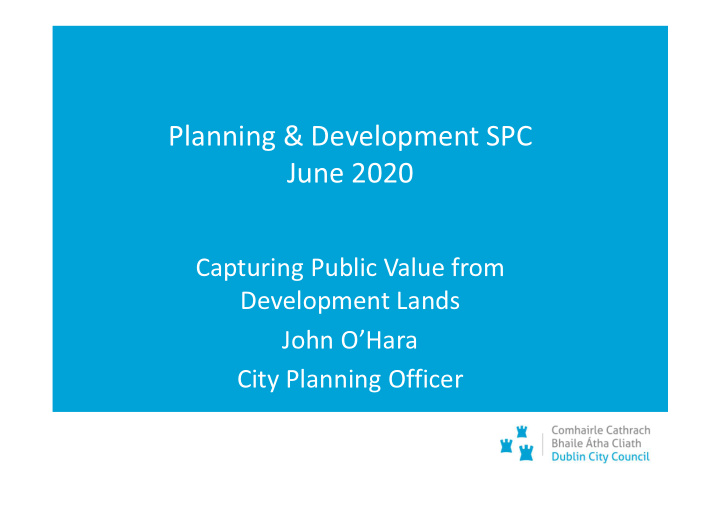



Planning & Development SPC June 2020 Capturing Public Value from Development Lands John O’Hara City Planning Officer
Capturing Public Value from Development Lands : Underlying Principles/Assumptions: Urban Living is future, but challenges; • Climate Change Urban Sprawl Congestion Deteriorating Infrastructure • State/Local Authority Actions Should generate public societal benefits by Public Infrastructure:- streets, schools etc. Zoning Land • If value uplift can be captured it can be invested in infrastructure/affordable housing for key workers.
Previous Government Initiatives • 1973 Kenny “ Report of the Committee on Price of Building Land” • Brief; Identify measures to control price of land for housing Ensure that all, or most of increased value use for benefit of communities Identify changes in legislation needed • Findings of Kenny Report Price of serviced land rose 530% 1963-71 Underdeveloped Land in Designated Areas be CPO’d at EUV i.e. agricultural value plus 25% This “betterment” should be used for benefit of community
Previous Government Initiatives – cont . Minority Report recommended that in Designated Areas, Local Authorities • would have first option to purchase land for sale. Levy of 30% charged on all Disposals PS – Kenny Report not implemented due to concerns re Constitutionality • (not tested in Courts)
Other Government Initiatives 1982 – Commission of Taxation: Echoed Kenny Report, but proposed a • high single rate of tax – combining “betterment” and Capital Gains Tax NAMA Act 2009 provided for windfall tax of 80%. (Removed by Minister • Noonan in 2015 and replaced with standard CGT of 33%) One reason: Little tax collected since 2010
Tools Currently Available to DCC To partly cover costs of developing zoned land 1. Development Contributions (S48) General levies collected by LA to fund Capital Projects across city @ €92.10m2 (Res) €96m2 (Commercial) 2. Special Development Contribution (S49) eg LUAS Cross City and LUAS Docklands @ €2000 per Res unit/ €38m2 (Commercial) 3. Vacant Site Levy To encourage development on Vacant sites @ 7% of site value
Tools Currently Available to DCC 4. Planning Requirements (via Legislation/Devp Plan Policy) Part V Housing @ 10% Public Open Space @ 10% Creche Provision 5. SDZ Designation Scheme can require infrastructure to be provided by landowner eg new streets, public space, school site 6. Community Gain e.g. Waste to Energy plant Issue: % of value uplift which these measures capture
International Approaches http://files.nesc.ie/nesc_secretariat_papers/No_14_InternationalApproachestoHousingandUrbanDevelopment.pdf http://files.nesc.ie/nesc_reports/en/145_Urban_Development_Land_ExSum.pdf • Netherlands Active Land Management by Municipalities Dutch National Bank – Low cost finance for Municipalities 3 Approaches 1. Building Claims Model Municipality buys land by Agreement! – installs infrastructure as per Masterplan; and parcels out land to developers who bid competitively. Sells back to developer(s) 2. Joint Venture Co Between Developer and Municipality. Which acquires land and services it 3. Concession Model Developer assembles land and services it: Masterplan done in co-operation with Municipality
International Approaches – cont . • Germany Urban Development Zones Designated (as a last resort) Land assembled at EUV; municipality provides infrastructure, and sells building plots in accordance with LAP Cost of assembly/infrastructure covered by difference between EUV and final value post infrastructure e.g. Freiberg; Hafencity, Hamburg • Austria Larger part of public expenditure devoted to subsidies (50% of new housing since 2000 in Vienna is social) Housing Fund (set up 1984), purpose to buy, service and sell land, for Cost Rental i.e. rent covers costs net of moderate subsidies
International Approaches • UK Section 106 Agreements between Local Authority and Developer to provide local infrastructure associated with development Community Infrastructure Levy (CIL), plus 30% Affordable Housing (subject to viability analysis) Claimed this equates to 50% capture of land value uplift
Some Conclusions for Ireland 1. More Pro-Active Land Management by Public Sector NPF 2040, and Compact City Growth is opportunity for more pro- active land management – balance between Section 40 (Property Rights) and Section 43 (the common good) of Constitution 2. Establish Strong but Accountable Urban Development Agency To work with Local Authorities, Government Departments; Infrastructure Providers and Land Owners to drive renewal of strategic areas To be able to set up and manage JV’s etc and low-cost financing arrangements. Role of LDA? 3. Develop Delivery Mechanisms For the Strategic Growth Areas in MASP – SDZ schemes too rigid?; v LAPs need Active Land Management Approach? Use of CPO powers as incentive?
Some Conclusions for Ireland – cont. 4. How to Capture and Distribute Value Uplift? National Exchequer? Who ringfences? Does it complement other funding e.g. S48, URDF. CGT, Property Tax 5. Need a Shared Value System Re: importance of good place making, timely infrastructure, affordable housing, balanced with reasonable profits
Recommend
More recommend